
Articles > Skiing WorldWide > Davos And Klosters
Davos Village Height: 1560 meters (5,117 ft), Klosters 1130 meters (3,706 ft)
An entrepreneurial Swiss saddle maker is credited with bringing skis to Davos and publicising their use through Sir Arthur Conan-Doyle, the creator of Sherlock Holmes. Tobias Branger first saw skis in 1889 at a trade fair in Paris. He ordered a few pairs of these 8-ft long boards for his Davos shop. To avoid ridicule from the locals they made their first forays under the cover of darkness. In 1894, together with Conan-Doyle they crossed to Arosa via the Maienfeld-Furgga Pass. An 8-hour epic that Conan-Doyle described in the popular Strand Magazine.
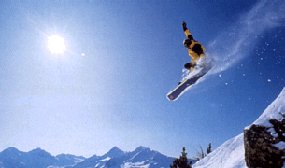
Today, the Davos ski region covers seven ski areas, each having its own character. Davos is a traditional ski resort; mountain railways, buses and cable cars link the various areas. A total of 13 different companies run these installations; to simplify life for the skier the whole area may be skied by holders of the REGA lift pass.
Davos is excellent for intermediate skiers and its famous off-piste itineraries offer a challenge to experts.
Like other, traditional resorts, Davos is not ideal to learn to ski from scratch. However, beginners can ski with the Swiss Snowsport School on their nursery slopes at Jakobshorn/Bolgen and at Bünda. Bolgen is a short walk from Davos-Platz railway station and Bünda from Davos-Dorf station. Bünda is the longer and steeper of the two nursery slopes. In Klosters, the sunny and user friendly slopes are up on the Madrisa mountain. This means buying a full lift pass or REGA pass and coming down on the Gondola at the end of the day. Once youve mastered the basics there are plenty of blue runs to keep you busy, for example the wide pistes of the Parsenn. Snowboarders shouldconsider the Top Secret Snowboard School at Bolgen.
Davos is the ideal resort for intermediates with the inclination to ski all the hours the lift company allows 08.00 until around 16.30. Most of the marked runs are red or blue and invitingly wide; some are over 10 km (6 miles) long with 2,000 metres (6,600 ft) of vertical. Just compare that to a top US resort like Jackson Hole (7.2 km/4,100 ft). The reds from the top of the Weissfluh to the villages of Kublis, Sass and Serneus start high above the tree line and track down through the woods to the railway line, offering adventure that is not available in the purpose built resorts. Be sure to check the train return times before you set out. A similar run, the Schlappin, begins high on the Madrisa and descends to Klosters Dorf through the eponymously named Valley.
The local mountains tend to be flatter on top confining many of the expert runs to the steeper valley sides. This may mean that they are icy unless there has been recent fresh snow. On a positive note they are generally below the tree line and so visibility is always good. The best conditions can be found on the north-facing Klosters area. For mogul experts the prime area is under the Schwarzeealp chair on the Gotschnagrat. The best black runs descend through the Meierhofer and Gruobenalp valleys down to Wolfgang (note: piste 16 seems to begin at the bottom of the Quad chair not the Parsenn T as shown on the piste plan). The Kulm restaurant makes a nice lunch stop before taking either the bus or train back to town. The Wolfgang piste is often skiable until the end of May although the Parsenn funicular only runs a limited service to transport researchers of the Swiss Avalanche Institute.
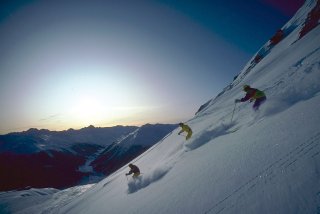
If you are prepared enough to fix skins to your skis and climb there is an enormous potential for deep snow adventure, especially mid-season. The longest runs are the 18-km itinerary routes to Fideris and Jenaz. Both require a climb from the Kreuzweg (crossroads) high on the Parsenn. The climb is fairly short, a couple of hundred meters to the Strassberger Furggli where there is a small hut. The route then descends into the tiny but charming ski resort of Heuberg. This is located at 2,000 meters in a natural north facing bowl and if it weren't for nearby Davos would have been an ideal location for a ski resort along the lines of Val Thorens. We were there on a Wednesday afternoon when the local girls school had its ski afternoon. At the hotel bar teenage girls lounged around in various states of undress catching the warm spring sun while their teachers skied. We stopped for lunch and a welcome beer. We had been expecting to done skins again for the climb of Hinteregg and were glad to pay a few francs to use the tow. At the top a long traverse took us into the woods above Fideris and some difficult crusty snow. After setting out at 9 am we were glad when we skied down behind a wood mill and emerged by the railway station just in time for the 5.40 pm train.
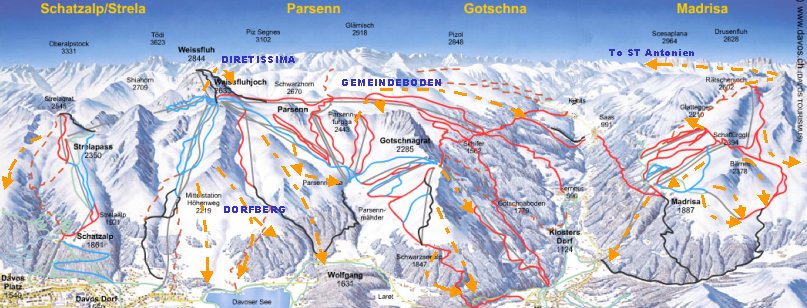
Parsenn also offers the off-piste descents of the Dorfberg and Gemindeboden as well as the steep Diretissima. The Diretissima can be used as the starting point to the Jenaz itinerary. Dorfberg is best in spring snow conditions and indeed in winter there is a considerable avalanche risk in the gullies that lead down to Dorf and Wolfgang.
The hardest challenge in the whole resort is the off-piste under the Kloster's cable car. This used to be a marked itinerary but skiers are discouraged from skiing this descent. The descent from the Gotschnagrat down to Bad Serneus is one of the steepest itineraries and will leave limbs aching at the bottom but with the treat of a hot sulphur bath then coffee and cakes for the well prepared.
Madrisa has been recommended for learning powder technique ask the Swiss Snowsport School in Klosters or Saas for current conditions and classes. It is also the starting point for the cross-border tour to the hamlet of Gargellen at the head of the Montalon Valley. The descent under the bubble lift is only suggest in the best snow conditions.
It is also possible to follow in the footsteps of Conan-Doyle and the other ski pioneers. This is a more serious business, requiring a 4 hours climb from Frauenkirch followed by a forgiving descent through the woods, Arosa is then reached after a half hour trek to the Station for the return to Davos via Chur and Landquart. A less taxing alternative is to ski off the back of the Parsenn via either the Haupter Talli or from the slightly steeper and more exposed Strellapass this brings you nicely down to the railway station at Langweis on the Arosa railway.
Pischa offers the interesting Tschuchenberg itinerary and, in spring snow conditions the descent behind the Seehorn to the main road is bliss. The longer off-piste to Hofwald and Laret are popular with the locals. If you are prepared to climb it is possible to ski to Klosters via the Pischahorn.
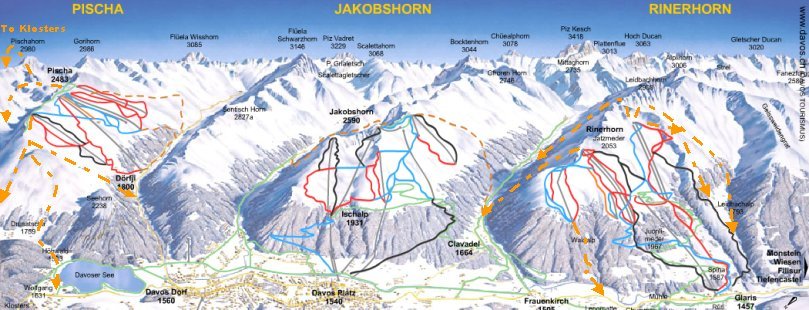
Jakobshorn has two marked itineraries. The more challenging is Teufi with a steep entry from the top of Jakobshorn to the solitary Dischmatal. Mühle is more relaxed but be sure to follow the path of the piste markings as off-piste in the forest is very steep and dense in places. Both require a bus trip or a long pole back along the road if conditions permit.
Rinerhorn is renowned for its off-piste run from the Nullisch Grat to Sertigtal. This requires a short hike from the lift then has a very steep entry. The Waldalp run through the trees is pleasant in poor weather when there is sufficient snow and the runs off the Leidbachalp are exquisite in spring snow conditions.
Guides for off-piste and ski touring can be arranged through the Swiss Snowsport School in Klosters, Saas or Davos or through the Top Secret Snowboard School. The Ski Club of Great Britain also run week long off-piste holidays. The SSS are equipped with avalanche transceivers and the revolutionary AVS rucksack (like an airbag on your back that keeps you buoyant if caught in an avalanche.
For those wishing to try things for themselves I've included two piste maps annotated with additional off-piste routes. I was helped by Ted from the Saas Ski School in preparing these maps.
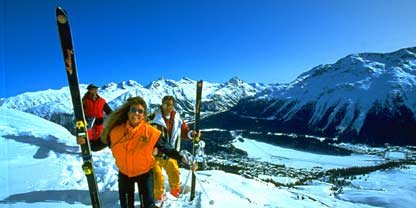
The western mountain area sees the sun first; it is therefore a good bet for morning skiing, although the extent of some of the areas will keep you exploring the whole day. The main feature of the Western ski areas is that they are all linked. A keen skier could start at Schatzalp, traverse across the Parsenn to Klosters and end up high on the Swiss/Austrian border at Madrisa covering a vertical descent greater than Everest!
The Schatzalp funicular railway hidden near to the Tourist Office in Davos-Platz serves this small area. The area features a two-man chair and a pair of T-bars. Two challenging marked off-piste runs descend through the Guggerbachtälli to the funicular top station. The Strelapass Shatzalp blue is also of a good standard. The Parsenn area can be reached via the Hauptertällibahn cable car and T bar lift. In fact this is my favourite entry point into the Parsenn. In February when you can wait an hour for the Parsenn funicular you can get straight onto the Schatzalp railway. The Parsenn funicular has the advantage of keeping the pistes higher up empty but is soon to be replaced by a high speed lift.
Schatzalp also features a scary floodlit sledge run back into town.
Summary from the Sudostschweiz, 2nd October 2002
Instead of the five winter ski areas long offered by Davos there will be only four this coming winter. The management of the mountain hotel Schatzalp AG yesterday decided to close the Schatzalp/Strela ski area.
Davos, proud to market itself as an Alpine metropolis, has had to let its guests know that for next winter there is less skiing on offer. The Schatzalp Mountain hotel yesterday took the decision to close the ski lifts in the winter sports area of Schatzalp/Strela for the forseable future.
This news has not surprised Davos. Henri Zegg, CEO of the Schatzalp Berghotel had already warned in July that because of mounting losses they would have to close the ski area although the Art Nouveau Schatzalp hotel will stay open along with its funicular railway and sledge run. A search is on for investors for the whole area.
Thanks to Simon Brown for pointing out this news.
The Davos Schatzalp is once again in the hands of locals. Puis App an Erich Schmid have staged a takeover of both the Art Nouveau Schatzalp hotel, built in 1899 and the Schatzalp/Strela lifts. At the end of the last year the lift operation was closed down by the old owners. The first priority for the new owners is the hotel but they then hope to put the ski lifts, including the cable car link to the Parsenn, back into operation. The town hall was pleased with the news and hopes for a happy end to the Schatzalp story.
The Parsenn is the largest ski area in the region. The slopes, which are shared with the attractive village of Klosters, developed gradually. The funicular opened in 1931 the first T-bar in Switzerland (and probably the world) was installed in 1934. The Parsenn can be reached from the two stage Gotschna or Schatzalp/Strela cable car connections and directly from the Parsenn funicular.
When people talk about queues in Davos they are talking Parsenn. By contrast the outlying areas, with modern lift systems are remarkable empty, even at peak times.
The Meierhofer valley is ideal for snowboarders and features a half-pipe. Worth a visit just to watch the tricks. From the Weissfluh mountain the Gipfel/Standard Ersatz pistes (2, 6 and 9) descend back to the Parsenn funicular giving a total vertical descent of some 1300 metres. Alternatively the red down to Kublis is the longest in the whole Davos region at 11 km with over 2,000 metres of vertical. Return the Parsenn is by train to Klosters then the Gotschnagrat cable car. Kublis has a cafe on the railway platform, and apart from excellent food there are indicators giving you enough time to finish your meal and pay. The pretty Swiss girls who serve there wear traditional dress.
The Saas run is served by a small tow up to the railway halt, be careful not to miss the train, the climb up to the village of Saas is long and steep but there is a Gasthof in the centre serving excellent food with a view over the mountains. A bus then returns to Klosters.
The Parsenn mountain features many wide pistes ideal for intermediate skiers, especially those on carving skis. Indeed the Parsenhütte piste (15) is especially reserved for carving skis and is kept in good trim by snow cannons.
Skiers looking for a challenge may try the descent to Wolfgang (bus or rail link to Davos), either via the Meierhofer Tälli (13) or Wolfgang pistes (16). The Wolfgang piste can be found at the base of the Gruobenalp chair lift.
If you are looking to bump into Prince Charles then ski around the Gotschna region early in January. Officially he lodges at the Walserhof in Klosters but he is most visible on the Piste. The Köbel run is good for mogul experts. Marked off-pistes also run down from the Gotschnagrat through the Drostobel and Chalbersäss valleys. Gentle blues can be reached by the Gruobenalp chair and Parsennmälder T lifts. A red, quite narrow in places, descends to Klosters station. Due to the installation of high-performance snow cannons (the local joke is that they caused an avalanche last year) and northerly aspect the run was open every day during last season.
Madrisa is great for beginners who can reach it after a pleasant 20 minute train journey to Klosters (included in the lift pass). The Saas piste, having a sunny aspect, often lacks snow cover for the full descent on skis. The Flue and Schlappin valleys provide challenging descents back to Klosters Dorf. The Rätschenjoch itinerary is often great for powder. The Pizzeria at the bottom of the bubble lift in Klosters Dorf is especially recommended but often very busy.
The east mountains catch the sun around mid-morning and then see it set at about 4.30pm in the Winter through to early evening in the Spring. Each valley is separate and they are interconnected by bus or rail links.
The most remote ski area in the region Pischa. It is reached by bus 7 from the Promenade. Often good in the morning as it faces due south, skiers can cruse the many wide-open red runs. The Mittel run (7) is sculpted for snowboarders with a series of jumps and bumps. Powder can often be found days after the last snow on the Tchuggenberg off-piste, although early morning is better as at the bottom the snow can get quite heavy. At the road skiers must cross over and join the Unterer Tälli run that follows a path by the river.
From the start of the 2007 season Pischa, which had been closed last year, has been repositioned as a Freeride Zone. According to the lift company it aims to appeal to snow-sports fans seeking an alternative to prepared slopes and also provide the chance to try out other trend sports and specialized snow-sports equipment. There will be an Avalanche Training Centre with training programs for avalanche dogs and mountain guides. The gondola lift and two lifts will resume operation to serve this area leaving two other lifts in mothballs. Three runs will be marked and secured but left unpisted. The boardercross zone will be restablished and there will be signposted snowshoe routes. Other more extreme activities will also be offered.
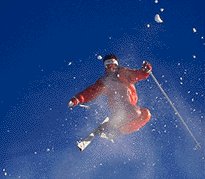
The Jakobshorn is just behind the Platz railway station. Its central location makes it popular with both locals and weekends. It can therefore get quite crowded at peak times. Both a cable car and a two-man chair lift serve the area. The cable car links to another car that whisks you to the summit at 2590 metres in about 15 minutes. From here you can take the Nord piste (5) down to the Usser Isch four man chair lift or you can ski over to the Ischalp T bar or take an easy blue to the Clavadeler Alp six man chair lift (new this year, replacing last years four man chair).
To return to the valley take either blue Mattenwald (3) or black Gämpen (10) pistes. The black piste is particularly narrow and should only be attempted by good skiers. Snowboarders and beginners are advised to avoid both pistes and take the chair or cable car down. These pistes give a total descent of 1030 metres.
The Bolgenschanz bar is the place to go in the evenings.
Jakobshorn is also a mecca for snow boarders with its half-pipe and snowboarders hotel. The half-pipe is flood lit until 9pm. Boarders can be seen attempting all manner of tricks.
Walkers can climb to the Clavadeler restaurant from either the Islen rail halt or the Waldfriedhof bus stop.
First aid points are either the Jakobshorn restaurant or the Ischalp cable car station.
The Rinerhorn lies at the most southerly extend of the Davos region, however it is not to be ignored with a mixture of challenging blacks and reds. It is reached either by the Fideris train that stops at Glaris or by the number 7 bus. Particularly interesting is the Brand, a wide black that descends from the Nüllisch Grat through woods and fields to the cable car station. This gives skiers a total of 1050 vertical metres over some 5 km. The wide Juonli and Wang pistes are ideal for practising fall line turns. The 2.8 km Standard blue is ideal for more advanced beginners.
Rinerhorn is a good bet in bad weather as there are many tree level descents.
The sledge run is floodlit until 9pm, during the day it is manic as kids belt down on toboggans racing neck and neck like Grand Prix drivers.
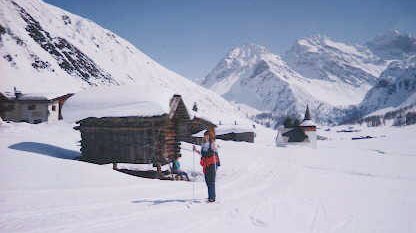
Davos and Klosters are renowned for their cross-country skiing. The Davos Tourist board maintains 75 km of marked classic and skating trails. Cross-Country equipment can be hired through our suppliers
Good skiers may like to try the 24-km piste to the remote Sertig valley. Alternatively there is the 13-km loop by the Davoser See and Wolfgang. Lunch may be taken at the Kulm restaurant at Wolfgang.
Snow shoes were originally an essential piece of equipment for inhabitants of Northern regions to enable them to move around in the deep mid-winter. With sometimes uncertain snow cover at low altitudes the sport of snow shoeing has experienced a recent upsurge in interest. New forms of shoe, constructed with advanced materials, have revolutionised the sport. Snow shoeing takes little time to learn and can make areas that previously only expert skiers could reach accessible to neophytes. With its forested mountains Davos is ideal for snow shoe treks.
<< Bulgaria | Skiing WorldWide | Haldenköpfle >>